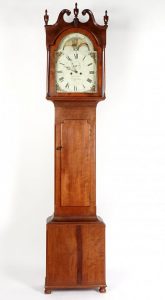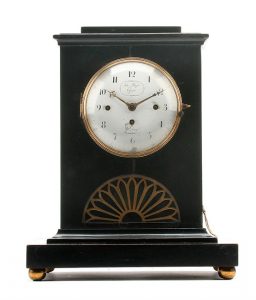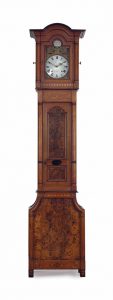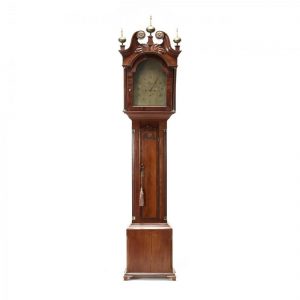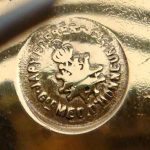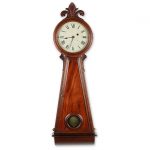Cherry Wood Clocks. Cherry wood has a warm rich appearance although there are differences in the color and characteristics of the heartwood and the sapwood.
The heartwood of Cherry is a rich reddish brown which darkens over time with exposure to light and air. The sapwood is usually a creamy, satin white. Both heartwood and sapwood are used for a variety of applications.
Cherry wood is known for its smooth texture and fine workability. Reference: Cherry Outlet.
Below are some examples of cherry wood clocks.
Samuel Sturgeon Pennsylvania Tall Case Clock
Circa 1810-1820, cherry case American tall case clock. Swan neck broken arch crest bonnet, turned wood urn finials, thin tapered full column accents. Blind door trunk, stepped base, all on four pad feet. Painted metal dial with moonphase and second aperture, floral vignettes in corners, marked Sam’l Sturgeon, Shippensburg, unmarked movement. Overall 94.25″ h. x 20″ x 11″. Condition: Chips and craquelure to dial, crack to base, currently running however not guaranteed to continue or keep accurate time.
Sold for $2,600 at Amero Auctions in 2019
Exceptional Federal Cherrywood Tall Case Seven-Tune Musical Clock, Martin Cheney, Windsor, Vermont, Circa 1809 dial inscribed M. Cheney / WINDSOR and the tunes: St Mary. = Marquis of Granby. = Duke of Argyle = Mrs Casey = New Jersey = Scotch Luck = Pleasures of Solitude. Height 105 in. by Width 26 in. by Depth 14 in.
Martin Cheney was one of three sons who learned the trade from their father, Benjamin, in East Hartford, Connecticut. The brothers relocated to southern Vermont around 1800, Martin settling in Windsor, Russell in Putney and Asahel in Royalton. After about nine years, Martin moved north to Montreal where he carried on his business into the late 1830s. The three-train brass musical movement shows the influence of the Cheney family’s Connecticut roots. On the outside, it appears to be a Daniel Burnap movement, with the bulbous pillars, deadbeat escapement and count wheel strike that are generally associated with his work. The ‘Osborne’ dial is made of painted iron and was imported from Birmingham, England. The chimes play seven tunes of 10 bells and hammers, changing automatically at midnight, or manually by hand. The f holes on the sides of the hood are similar to those found on a violin.1
This rare and important Musical Tall Clock descended in the Cutting family of Weathersfield, Vermont and is signed by the maker, “M. Cheney, Windsor,” for Martin Cheney of Windsor, Vermont. A possible original owner may be Jonas Cutting I (1762-1842), whose son, Jonas Cutting II was born in Weathersfield, VT in 1790. Martin Cheney was born in East Harford, CT, the son of the clockmaker Benjamin Cheney (active 1745-1780). He trained under his father and in 1805 moved to Windsor, VT, where he established his own clock making business. His life and career are discussed in Vermont Clock and Watchmakers, Silversmiths and Jewelers, by Lilian Baker Carslisle. According to the author, “Martin Cheney, clockmaker and silversmith, was born in 1778 in East Hartford, CT, the son of Benjamin and Deborah Cheney…His father was one of New England’s finest clockmakers and worked from about 1745 to 1780.
Benjamin Cheney and his brother Timothy Cheney were especially noted for their majestic tall clocks with wooden works cased in carved cherry wood cases…Martin, who probably served his apprenticeship with his father and uncle, came to Windsor about 1803 and on December 5 of that year married Fanny Patrick in that town.” The author noted the explosion of sophisticated architecture and furniture that filled Windsor, “The Birthplace of Vermont”, after 1800; “The constitution of Vermont was drawn up in Windsor and in this town many of the historic men of Vermont met and did business. With its growing power, the town attracted residents of a cultivated taste. Its architecture was the best of the times and the homes and taverns displayed spacious open porches, stately pillars, arched and corniced ballrooms for dancing – all early signs of advancing luxury. To embellish and dignify their splendid homes, the residents demanded furnishings of equal magnificence and there was a ready demand for the choice and elegant clocks made by Martin Cheney. Some of the clocks told not only the hours, but the days of the month and changes of the moon, and some of them had musical accompaniments with a tune for every day of the week, and a special meditative air for Sundays.”
With the complexity of the musical movement and inlaid decorated case, this clocks stands as a prime example of the products supplied by the sophisticated craftsmen that were drawn to Windsor during the Federal era. The clock’s size, complexity of movement, intricate decoration to the case, all support the clock’s significance from the day it was made until today. Interestingly, Martin Cheney only stayed in Windsor for five years, from 1805 to 1809, supporting a narrow manufacture date of these few years. After leaving Windsor, Cheney moved his business to Montreal, Canada, where his last known advertisement appeared in 1827.
Sold for 87,500 USD at Sotheby’s in 2018
A late 18th/early 19th Century German ebonised quarter-striking bracket clock with pull-repeat Johann Baptist Eyrich, Wurzburg Having a 5-inch white-enamelled convex Arabic dial, signed within a cartouche “Joh: Bapt: Eyrich” above “Wurzburg”, the three-train movement sequentially quarter-striking on a small bell and hour-striking on a larger bell, wth silk-suspended pendulum, the ebonised cherry-wood case, circa 1820, having a stepped top over convex glazed door, fan lenticle with gilt tracery, and rectangular plinth on ball feet, the rear door inscribed with dates from 1774 to 1789, plus ink number 3573, 36.5cm high
Sold for £ 264 inc. premium at Bonham’s in 2009
A LOUIS XV PROVINCIAL INLAID CHERRY AND BIRCH LONG-CASE CLOCK, 18TH CENTURY, THE DIAL SIGNED ‘TRAVEIS AINE AU CHEYLARD’ 105½in. (268cm.) high, 23¾in. (60.5cm.) wide, 15¾in. (40cm.) deep
Sold for USD 875 at Christie’s in 2013
Queen Anne Cherry Tall Case Clock 18th Century The molded crest over arched hood door flanked by free-standing columns, the silver dial inscribed Jon a Purinton Kensington, and with subsidiary seconds dial, arched case door and molded base with bracket feet. Height 7 feet 3/4 inches, width 20 inches, depth 9 1/2 inches.
Lacking finials, repair to feet, crack to case door and front of case; loss to upper cornice molding; hinge on has been over extended; cracking to upper right side of tympanum; lacking two finials
Sold for $2,812 (includes buyer’s premium) at Doyle in 2019
Chippendale Tall Case Cherry Clock, John Wood (Philadelphia, Active 1730-1761) 18th century, cherry, white pine secondary, hood with swan’s neck broken arch pediment, applied acanthus leaf carving below a tympanum with applied fluted block, brass suppressed ball finials, fully turned and fluted columns, brass face marked “John Wood, Philadelphia”, strike silent and date hand, Roman and Arabic numerals, waist with hinged lipped door featuring a relief carved fan and shaped and molded top, fluted quarter columns with brass capitals, base with front chamfered corners, later ogee bracket feet, with pendulum, two weight, waist key. 95 (to finial), 87.5 (without finial) x 22.5 x 10.5 in.
Sold for $2,000 at Leland Little Auctions in 2019
